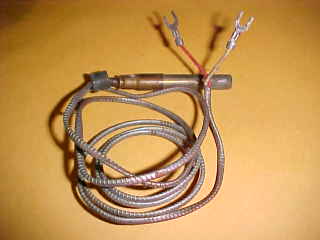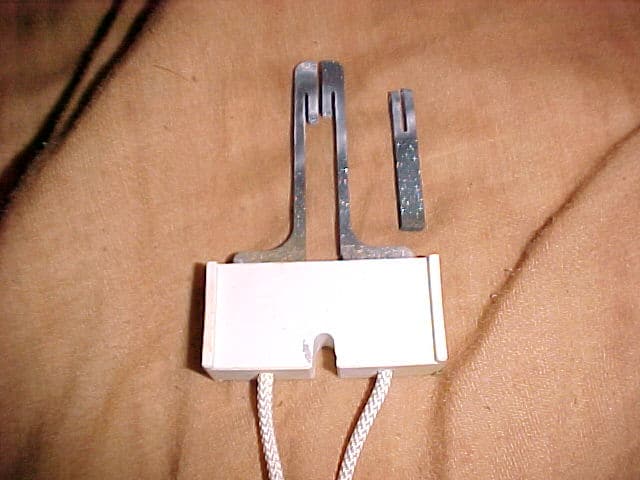I get many inquiries about problems with the pilot lights on gas furnaces. Unless you have a newer furnace with an electronic or electric ignition system, you probably have a standing pilot. That is a system where the pilot is always burning and is used to light the main burner. When you identify there is a problem with the pilot light, what gas valve do I need for my furnace?
There are two basic types of pilot lights. The first is the thermocouple system that uses two dissimilar metals to provide electricity to hold open the pilot valve on the gas valve once you light the pilot. The main valve is operated by 24 volts from a transformer.
The thermocouple is relatively generic. There are some versions that put out slightly more voltage than others and have a longer life rating. However, the ones that you buy at the home stores should work fine.

Notice the pilot tube connection on the left side of the valve and the thermocouple connection in the centre of the valve. Only standing pilot systems have a pilot position on the valve knob (you must push to light the pilot).
If you have an electronic (intermittent pilot ) system, The valve will have the designations MV MV/PV PV (main valve pilot valve and common) and no connection for a thermocouple. Hot surface ignition/direct spark valves will not have a pilot tube connection.

Notice the connection on end is the same as the connection on the gas valve to the left. This device is used on all standing pilot systems, including water heaters and commercial gas equipment, except Millivolt or some General Electric furnaces. They have a special gas valve that has a pilot gas output but no thermocouple connection, just a main gas valve (proven pilot). If you need to replace one of these turds, replace it with a standing pilot valve or an intermittent kit.
The second system of gas valve for furnace is called a Milli-Volt system. The pilot heats a larger device that generates a bit more electricity, enough to operate the main valve too. The theory is that if the pilot is not lit, then the main burner won’t work, and you don’t need a 24-volt transformer. This system is used a lot on mobile homes, RV furnaces, and swimming pool heaters because they will work without utility power.
If you have problems where the pilot light won’t stay lit after you release the button or knob, then replace the thermocouple. If you still can’t get the flame to stay, try another thermocouple, then replace the gas valve (sorry, there is nothing else that can be done). The problem is not with your thermostat or the furnace transformer.
Note: the thermocouple has nothing to do with the main valve opening, so don’t replace your thermocouple if the pilot is already lit.
The exception is on some old furnaces; they have a box with the thermocouple and a reset button for the main burner.

Newer furnaces will have intermittent pilot, hot surface ignition (HSI), or direct spark. The intermittent system uses a grey control box to spark the pilot and detect that it is lit. These boxes are very reliable, but when they fail, you are looking at at least $100 for the box.
Another system is called a cycle pilot. The pilot is lit by a pilot re-light module, and a mercury flame sensor allows the main valve to open. This same module can be added to a furnace that has a nuisance pilot that blows out frequently.

A proven pilot has a mercury sensor in the flame to allow the main valve to open (used on general electricity).
Hot surface ignitors are being used more and more today. The major advantage is the controls are cheaper. They just need a flame sensor to detect the main burner and open the main valve.
The problem with them is the ignitor burns out, and you are cold until you can get another one. When they fail, you can either replace the ignitor or convert the sensor board to a direct spark. If the sensor board fails, I would just convert it to a single-wire direct spark. That way, you eliminate future problems with the ignitor (you need a different one for every brand of furnace).
To test an ignitor, connect a 120-volt bulb (about 25 watts) in its place or use a multimeter. If you get 120 volts, but the ignitor doesn’t glow, then it is bad. When replacing it, be careful not to touch it with your fingers. Oil on your skin can shorten its life.
Conclusion
| If you have: | You will have: | You will not have: |
| “Standard standing pilot” with thermocouple. The gas valve is opened by 24 volts ac. | Pilot on all the time, thermocouple. Power required to open the gas valve. | HSI, combustion blower, gas flowing if the pilot goes out. |
| “Millivolt system”. meaning the gas valve is opened by the millivolt generator and not a transformer. | Pilot on all the time , millivolt generator, millivolt gas valve. | HSI, combustion blower, possibly no transformer. |
| “Intermittent pilot”, The pilot is lit by a spark then the main burner comes on after it senses the pilot. The gas valve has the designations PV PV/MV MV. | A control box made by Honeywell, Robertshaw, or White Rodgers. A flame sensing rod, a high voltage lead. | A hsi ignitor. Probably not a combustion blower. A pilot that is lit all the time. |
| “Cycle Pilot” almost identical to “intermittent pilot” except uses a mercury flame sensor instead of a control module. | Pilot relight module. Mercury flame sensor. Same gas valve as an Intermittent pilot system. | Thermocouple. Gas valve control module. HSi Ignitor. A pilot that is lit all the time. |
| “Carrier/Bryant Glow Coil” Lights the pilot with a glow coil and then the heat from the pilot switches power to the main valve. | Mercury flame sensor or pilot switch. Glow coil that lights the pilot, same gas valve as intermittent pilot. | Hsi, thermocouple, possibly no control module. A pilot that is lit all the time. |
| “General Electric Gas Furnace” with original gas valve. | Gas to the pilot all the time, a pilot switch that sends power to the main valve when the pilot is detected. | Anything to shut off the gas if the pilot goes out. Replace this this thing with a standard standing pilot valve. |
| Old furnace with a standing pilot | A separate pilot tube conected to the gas pipe that supplies gas to the pilot. Just a solenoid type main valve, whith a thermocouple operated safety. | Anything to shut off the gas if the pilot goes out. |
| “Hot Surface Ignition” An ignitor heats up and lights the gas. The flame is sensed through “flame rectification” Used on most modern furnaces. | Flame sensor rod that feeds either a control box or a proprietary control module. Combustion blower on a condensing furnace. | Any kind of pilot at all. Pilot tubing, gas valve with a pilot outlet. |
| “Direct Spark” Almost identical to HSI except you have a high voltage spark lighting the gas instead of a hot element. | Flame sensing rod, Gas valve with no pilot connection. The same stuff as hsi system above. | The problems of failure that you have with hsi. These are used on roof top unit and other applications where servicing is difficult. |
To answer the question, what gas valve do i need for my furnace? A standing pilot is the most reliable and foolproof, but intermittent, HSI, or direct spark is good for situations where lighting the pilot is a nuisance and property damage could result.






